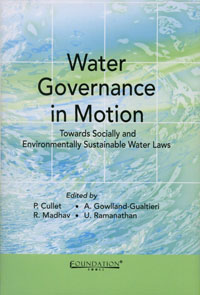/topics/governance
Governance
The Wetlands (Conservation and Management) Rules, 2010 notified by the MoEF
Posted on 04 Dec, 2010 01:01 PMThe Ministry of Environment and Forests today notified the Wetlands (Conservation and Management) Rules, 2010. These Rules have been drafted by the Ministry of Environment and Forests to ensure better conservation and management and to prevent degradation of existing wetlands in India.
Peer Water Exchange (PWX) receives 2010 Intel Environment Award
Posted on 29 Nov, 2010 04:40 PM
The Peer Water Exchange (PWX) was awarded the 2010 Intel Environment Award today. PWX, a project of Blue Planet Network, is a combination of process, technology platform, and people designed to unlock the global capacity and creativity of individuals, philanthropies, businesses and implementers to solve the global safe drinking water and sanitation crises.

e-Disha November 2010 newsletter from Consortium for DEWATS Dissemination Society (CDD)
Posted on 29 Nov, 2010 10:59 AMArticle and Image Courtesy: Consortium for DEWATS Dissemination Society

The November edition of e-Disha published by the Consortium of DEWATS Dissemination Society (CDD) has the following highlights:
Palak Dil Lake - Mizoram
Posted on 26 Nov, 2010 03:00 PMThe Mizoram state has three types of (natural) lakes: valley lakes, tectonic/landslide lakes and artificial reservoirs, but the only lake of significance is Palak Dil, which is a natural lake in a depression in the hills. Palak Dil may possibly be a combination of valley and tectonic lakes. Locally in Mizoram, lakes are called dils. There are many such dils scattered all over the state, but they are tiny pools or marshy depressions such as Rengdil, Tamdil and Mampui Dil (Choudhury 2002). The Palak Lake is situated within the Mara Autonomous district Council, which is a region inhabited by the Mara Tribe. The Maras are distinct from the majority Mizos and in the Mara language the Palak Lake is referred to as Pala Tipa.
Fluorosis water contamination in rural India - A video by Earth Report
Posted on 26 Nov, 2010 12:08 PMVideo Courtesy: EarthReport
Source: 5min Media
It has been proved that it's a direct result of drinking ground water that's contaminated with high levels of fluoride. This video suggests that rainwater is the best source of water for communities living in these regions.
Water governance in motion: Towards socially and environmentally sustainable water laws
Posted on 18 Nov, 2010 10:48 AM

Water Governance in Motion: Towards Socially and Environmentally Sustainable Water Laws focuses on the work undertaken by International Environmental Law Research Centre IELRC on water law reforms in India. It seeks to provide a broader understanding of the conceptual framework informing existing water law and ongoing reforms.
News roundup (8-15 November 2010) :"India proposes a new emission check system" and News round-up on the floods
Posted on 17 Nov, 2010 06:08 PMClimate Change
Environment
Workshop on "How to write a research paper" on Nov 19th, 2010 @ Probiosys- Centre for Excellence, Bangalore
Posted on 16 Nov, 2010 12:35 PMWriting a good research paper is a challenge, but it is very vital for students & researchers looking forward to publish their results.
People contemplating to make R&D as a career need skills to write good Research papers. This workshop is designed to impart skills to students and researchers to write better research papers.
United Nations World Water Assessment Programme is looking for "Publications Officer" for Global Water Assessment
Posted on 15 Nov, 2010 01:07 PMDescription
Operating under the direct supervision of the WWAP Coordinator and in close collaboration with all members of the WWAP Secretariat, the Publications Officer is responsible for managing the workload and flow of the programme’s publishing activities.
Environment Policy Guidelines of Department of Science and Technology - Government of Himachal Pradesh (2010)
Posted on 14 Nov, 2010 06:29 PMThis document outlining the Environment Policy Guidelines of the Department of Science and Technology, Government of Himachal Pradesh has developed approaches compatible with mountain ecosystems and its unique aspects such as fragility, inaccessibility, marginality, diversity, climatic peculiarities, scattered population and small agricultural holdings.





